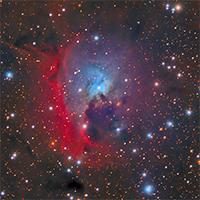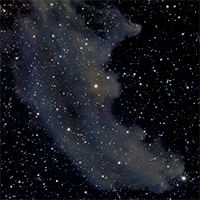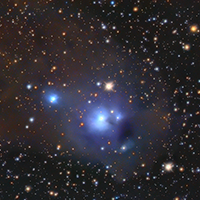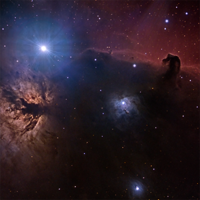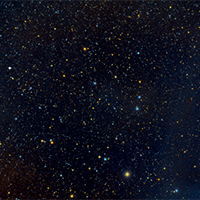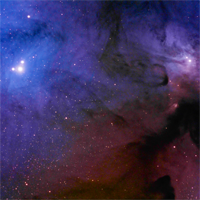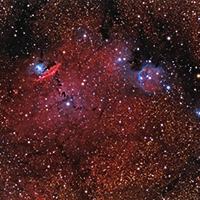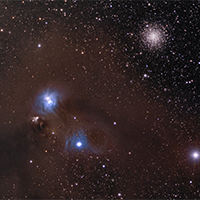Tagged: Reflection
02-Aug-2025
A swirl of stellar creation, the Trifid Nebula (M20) reveals its dual personality here: rose-pink hydrogen emission framed by the cool, silvery glow of reflected starlight. Dark dust lanes slice the central cloud into three, giving the nebula its name and lending a dramatic floral symmetry.
17-Jun-2020
NGC 2626 is a seldom photographed, spectacular reflection nebula in a sea of hydrogen emission clouds.
11-Apr-2019
IC 2118 (also known as Witch Head Nebula due to its shape) is an extremely faint reflection nebula believed to be an ancient supernova remnant or gas cloud illuminated by nearby supergiant star Rigel in the constellation of Orion.
25-Apr-2018
NGC5367 is a reflection nebula 2000 light years in the Centaurus constellation. The bright blue stars illuminate the otherwise dark molecular cloud complex.
04-Jan-2017
Adjacent to the bright blue supergiant star Alnitak shines the ionised hydrogen of the Flame and Horsehead nebulae.
03-Aug-2016
Almost everyone has a go at imaging the Trifid nebula, which is composed of 3 different type of nebulae; emission, reflection, and absorption. When I noticed some faint red glow in the background, I decided to try integrating some long hydrogen emission line frames to see if I could get any structure out of it. I'm quite happy with the resulting background structures!
13-Oct-2020
IC 4601 is a reflection nebula within the larger Blue Horsehead Nebula. Reflection nebulae are actually made up of dust that normally appears dark but can reflecting the light of nearby stars.
23-Jun-2019
Shown in this animation is the movement of Ceres over 8 hours, on the night of 4th June 2019, as it passed by the outer edge of IC4592, the Blue Horsehead Nebula.
27-Apr-2017
Inside the Rho Ophiuchi cloud complex live the star clusters IC4604 (left) and IC4603 (right). Heading towards the bottom of the image shows the transition from blue reflection nebulae to red emission nebulae. Interspersed are dark absorption nebulae, blocking the light from the stars behind them.
09-Aug-2016
Next to the Lagoon Nebula, there lies the often overlooked collection of absorption, reflection and emission nebulae: NGC 6559, IC 1274, IC 1275, IC 4684, IC 4685, Barnard 303, LDN 227, LDN 213, and planetary nebula PN M 1-41.
26-Jun-2016
Less than 500 light-years away and blocking light from more distant, background stars in the Milky Way, the densest part of the dust cloud of Caldwell 68 is about 8 light-years long. At its tip is a group of reflection nebulae cataloged as NGC 6726, 6727, 6729, and IC 4812. A characteristic blue color is produced as light from hot stars is reflected by the cosmic dust.

